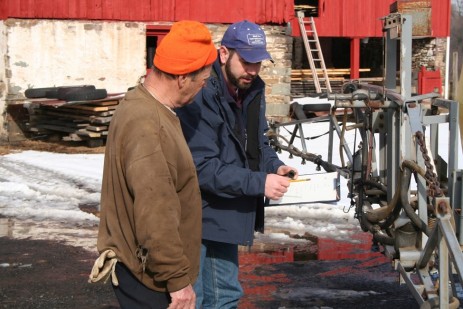April 13, 2018

Source: Penn State University
By Andrew Frankenfield, Penn State University
Sprayer calibration can save money on over application of herbicides and ensure you are applying a uniform rate across the entire field. Simply relying on your pressure gauge, gear and tachometer settings from last year just simply aren’t enough! Calibration is an essential task to let the applicator know you are applying the correct rate of product. If the rate is too low, you risk product failure, in addition to wasting time and money. Too high of a rate wastes chemical, may violate the label, also wastes money, and poses a risk for pollution.
Before you calibrate, you should first check over any hoses, pumps, and valves for proper operation. Look over the condition of the tank (and the straps that hold the tank to the frame) for any unusual wear. Check your nozzle spacing on the booms, to make sure it is uniform. Clean all your nozzles and strainers with warm, soapy water. Also, be sure to clean out the sprayer tank.
Next, you should insure uniform output of nozzles. Here are the steps to complete the nozzle check:
1.Using a calibration cup (or a graduated container marked in ounces) catch the output from each nozzle for 20 seconds and write down the number of ounces.
2.After catching the spray from every nozzle, add the amounts caught and divide by the number of nozzles to get the average output per nozzle.
3.If the output from any nozzle is more than 10 percent above or below the average, clean or replace that nozzle.
4.Recheck the output from any cleaned or replaced nozzle. Use the new output to figure a new average. If more than 2 nozzles have output rates 10 percent above or below the average, replace all of them, and repeat steps 1, 2, and 3 to be sure the flow rate is uniform.
Finally, we can calibrate. I like to use the 1/128th of an acre method to calibrate a boom sprayer. Below are the steps to using this method:
1.Use the table to find the distance you must travel to cover 1/128th of an acre per nozzle. This is done by measuring the nozzle spacing on the boom, and referencing the chart for the distance needed. Mark off this distance in the field, allowing space for the sprayer to reach full operating speed before reaching the first marker of the test course.
2.Fill the tank half full with water (no pesticide). Make at least two runs over the marked distance with all the equipment that will be used during the application. Use the gear and throttle settings that will be used during the actual spraying. Obtain an average time in seconds the sprayer takes to travel the marked distance.
3.Park the tractor and adjust sprayer pressure to the level that will be used for application. Using a container marked in ounces (calibration cup), catch the output from a single nozzle for the length of the average travel time. The number of ounces collected from one nozzle is equal to the output of the entire sprayer in gallons per acre (GPA).
4.Compare the actual application rate with the recommended or intended rate. If the actual rate is more than 5 percent higher or lower than the recommended or intended rate, you must make adjustments.
5.Start the adjustments by changing the pressure. Lowering the spray pressure will reduce the spray delivered; higher pressure means more spray is delivered. Remember not to vary from the pressure range recommended (by the manufacturer) for the nozzles in use.
6.Another way to correct the application rate is by changing the actual travel speed. Slower speeds mean more spray is delivered; faster speeds mean less spray is delivered.
7.If these changes do not bring the application rate to the desired rate, you may have to select a new set of nozzles with smaller or larger orifices.
8.Recalibrate the sprayer after any adjustment.

Example:
• Your sprayer nozzle spacing is 20”.
•According to the table you need to calculate how long it takes to drive 204 feet.
•It takes you 28 seconds to drive the 204’.
•You collect 20 ounces from one nozzle in 28 seconds.
•Your spray rate based on water is 20 gallons per acre (gpa).
If you are spraying 28% UAN you need to adjust your sprayer to get the desired rate because its density is greater than that of water. The conversion factor is 1.13 for 28%-0-0.
To apply 20 gallons per acre of 28% you need to calibrate your sprayer to apply 22.6 gpa of water (20 gpa x 1.13=22.6 gpa)
In the situation above you have 2 options to increase your rate, either slow down or increase your pressure. If you are running a relatively low pressure it is easiest to increase your pressure and maintain the same ground speed.
Once you fine tune your adjustments to your desired rate be sure to write that information down and keep it in a place you will be able to find again.
You May Also Like




